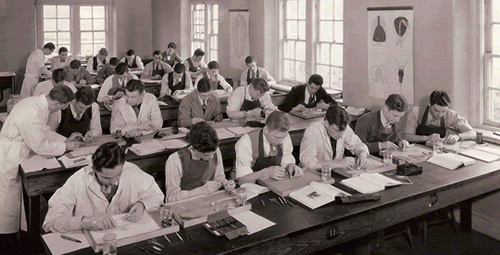Origins of Optometry

Optometry as a discipline traces its roots back roughly 2000 years, to the Greeks. Aristophanes wrote of using a glass to magnify the sun’s rays to erase writing on wax tablets in his work “The Clouds.” At about the same time, the Chinese began using spectacles over the eyes (though their purpose was probably to ward off evil spirits).
About 1000 years ago, the Venetians began using glass spheres to magnify text as an early form of corrective vision, and in China, researchers believe proper spectacles were taking shape. Even Venetian Marco Polo describes glasses in his travels East in the 1260s.
Early Modern Optometry: Foundations
In 1263, Roger Bacon first prescribes lenses for those weak-of-sight. In his Opus Majus, Bacon writes, “If anyone examine letters or other minute objects through the medium of crystal or glass or other transparent substance… he will see the letters far better and they will seem larger to him.” By 1300, Europeans were making spectacles.
Neuroscientists often cite Johannes Kepler for his pioneering work on the function of the human eye. He writes in his 1604 work Astronomiae Pars Optica (usually considered the beginning of modern optometry), that images are projected inverted and reversed by the eye’s lens onto the retina. Kepler’s work sparks a series of developments in optometry, and in 1629 England grants its first charter to spectacle makers.
A Series of Progressions
By the end of the 18th century, Benjamin Franklin had invented the bifocal lens (1784), John Dalton described colorblindness (1798), and Thomas Young had successfully mapped the normal visual field of humans (1801). The mid-19th century saw the development of sets of trial lenses to determine lens prescriptions, followed closely by the invention of the ophthalmoscope, which allowed optometrists to view the interior of the living eye.
Then, in 1856, Hermann von Helmholtz published his Handbook of Physiological Optics, a massive treatise in three volumes, which was translated from German to English in 1924. Cylindrical lenses began being used about the same time that optometry as a term began being used in conversation, about 1865.
Optometrists eventually began experimenting with contact lenses, and in 1888 the first successful use of corrective vision contact lenses was documented. That same year, Handbook for Opticians, by William Bohne, became the first textbook written by an optometrist for optometrists was published.
By 1921, the United States recognized the optometry field in an effort to protect and regulate the profession, further solidifying its importance in the greater medical community. From the mid-1950s until now, optometrists have continued to develop new technology and approaches to examining the eye and improving vision, from soft contact lenses to laser surgery and beyond.
[Photo Via: Salus]

